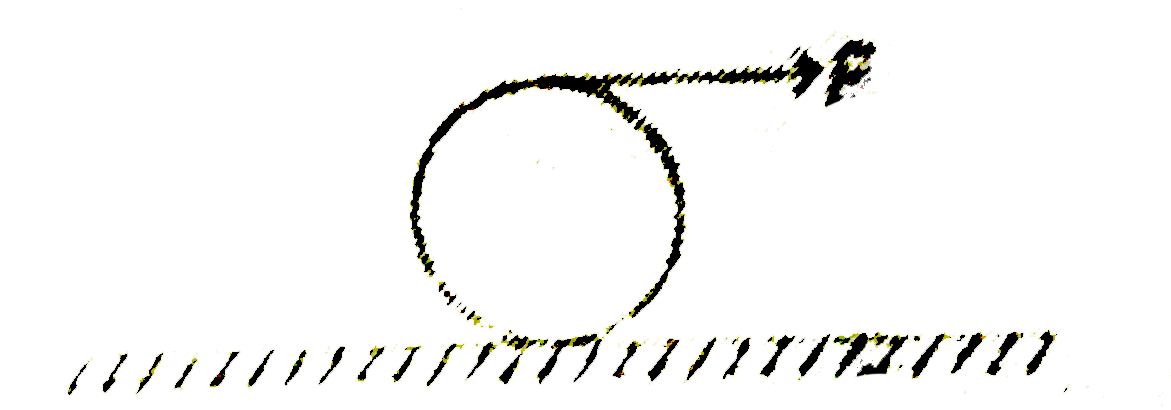Let r be the distance of a particle from a fixed point to which it is attracted by an inverse square law force given by F=k/r2 (k=constant). Let m be the mass of the particle and L be its angular momentum with respect to the fixed point. Which of the following formulae is correct about the total energy of the system?
(a) 12m(drdt)2−kr+L2mr2=Constant
(b) 12m(drdt)2−kr=Constant
(c) 12m(drdt)2+kr+L22mr2=Constant
(d) None
The correct Answer is:A
To solve the problem, we need to derive the total energy of a particle under the influence of an inverse square law force, given by F=kr2, where k is a constant, r is the distance from a fixed point, m is the mass of the particle, and L is its angular momentum.
1. Identify the Total Energy:
The total energy E of the system consists of kinetic energy K and potential energy U:
E=K+U
2. Calculate the Potential Energy:
The potential energy U associated with a conservative force can be found by integrating the force:
U(r)=−∫Fdr=−∫kr2dr
The integral of kr2 is:
U(r)=−(−kr)+C
Assuming the potential energy at infinity is zero (U(∞)=0), we have:
U(r)=−kr
3. Calculate the Kinetic Energy:
The kinetic energy K can be expressed in terms of the radial and angular components of velocity. The total velocity v can be expressed as:
v2=v2r+v2θ
where vr is the radial component and vθ is the tangential component. The tangential component can be related to angular momentum L:
vθ=Lmr
Thus, the kinetic energy becomes:
K=12mv2=12m(v2r+(Lmr)2)
Simplifying this, we get:
K=12mv2r+L22mr2
4. Combine Kinetic and Potential Energy:
Now, substituting the expressions for K and U into the total energy equation:
E=12mv2r+L22mr2−kr
5. Final Expression for Total Energy:
The total energy can be expressed as:
E=L22mr2+12mv2r−kr
Conclusion:
The total energy of the system is given by:
E=L22mr2+12mv2r−kr
The total energy E of the system consists of kinetic energy K and potential energy U:
E=K+U
The potential energy U associated with a conservative force can be found by integrating the force:
U(r)=−∫Fdr=−∫kr2dr
The integral of kr2 is:
U(r)=−(−kr)+C
Assuming the potential energy at infinity is zero (U(∞)=0), we have:
U(r)=−kr
The kinetic energy K can be expressed in terms of the radial and angular components of velocity. The total velocity v can be expressed as:
v2=v2r+v2θ
where vr is the radial component and vθ is the tangential component. The tangential component can be related to angular momentum L:
vθ=Lmr
Thus, the kinetic energy becomes:
K=12mv2=12m(v2r+(Lmr)2)
Simplifying this, we get:
K=12mv2r+L22mr2
Now, substituting the expressions for K and U into the total energy equation:
E=12mv2r+L22mr2−kr
The total energy can be expressed as:
E=L22mr2+12mv2r−kr
The total energy of the system is given by:
E=L22mr2+12mv2r−kr
Topper's Solved these Questions
- WORK, POWER & ENERGYBook:CENGAGE PHYSICS ENGLISHChapter:WORK, POWER & ENERGYExercise:Multiple Correct
Explore 25 Videos
- WORK, POWER & ENERGYBook:CENGAGE PHYSICS ENGLISHChapter:WORK, POWER & ENERGYExercise:Linked Comprehension
Explore 55 Videos
- WORK, POWER & ENERGYBook:CENGAGE PHYSICS ENGLISHChapter:WORK, POWER & ENERGYExercise:Subjective
Explore 23 Videos
- VECTORSBook:CENGAGE PHYSICS ENGLISHChapter:VECTORSExercise:Exercise Multiple Correct
Explore 5 Videos
Similar Questions
A particle with the position vector r has linear momentum p. Which of the following statements is true is respect of its angular momentum L about the origin ?
View SolutionA particle of mass m is revolving in a horizontal circle of radius r under a centripetal force k/r2 where k is a constant. What is the total energy of the particle ?
View Solution
Knowledge Check
A particle of mass m is moving in a horizontal circle of radius r, under a centripetal force equal to (−K/r2), where k is a constant. The total energy of the particle is -
A−krB−k2rCk2rD2krThe formula above is Newton's law of universal gratitation, where F is the attractive force, γ is the gravitational constnat, m1andm2 are the masses of the particles, and r is the distnace between their centres of mass. Which of the following givers r in terms of F,γ,m1,andm2?
Ar=√(m1)(m2)γ(m2)Br=√F(m2)γ(m1)Cr=√γ(m2)F(m1)Dr=√γ(m1)(m2)F
A particle of mass m is moving in a horizontal circle of radius R under a centripetal force equal to −Ar2 (A = constant). The total energy of the particle is :-
(Potential energy at very large distance is zero)
View SolutionPotential energy of a system of particles is U=α3r3−β2r2, where r is distance between the particles. Here αandβ are positive constants. Which of the following are correct for the system?
View SolutionThe potential energy of a two particle system separated by a distance r is given by U(r)=Ar where A is a constant. Find to the radial force Fr, that each particle exerts on the other.
View SolutionA particle of mass m is fixed to one end of a light rigid rod of length l and rotated in a vertical ciorcular path about its other end. The minimum speed of the particle at its highest point must be
View SolutionA sphere of mass M rolls without slipping on rough surface with centre of mass has constant speed v0. If mass of the sphere is m and its radius be R, then the angular momentum of the sphere about the point of contact is.
View SolutionA constant force F is applied at the top of a ring as shown in figure. Mass of the ring is M and radius is R. Angular momentum of particle about point of contact at time t

View Solution

